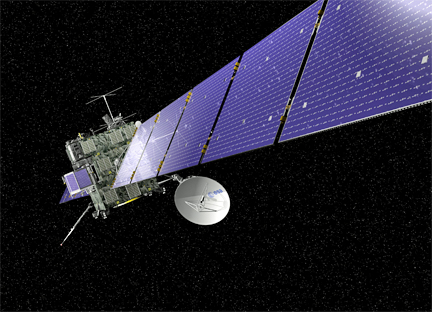
[SatNews] After its 10-year journey, Rosetta is the first spacecraft to rendezvous with a comet...

The view of Comet 67P/Churyumov–Gerasimenko from Rosetta on August 3rd.
The European Space Agency's ambitious "comet-chaser" Rosetta space probe, which is one of the numerous scientific spacecraft that received an "initial push" with Arianespace's launch services,- continued its mission to explore the Universe, meeting up with with comet 67P/Churyumov-Gerasimenko on Wednesday.
Launched on an Ariane 5G+ version of Arianespace's workhorse heavy-lift launcher in March 2004 from the Spaceport in French Guiana, Rosetta was successfully placed on an Earth-escape trajectory that began a 10-year journey through the Solar System toward its comet destination. Designed to chase, orbit and land a probe on a comet, Rosetta includes an orbiter and the "Philae" landing probe, which is scheduled for deployment to the comet's surface this November. Following Rosetta's arrival, the spacecraft will study the comet and its environment for nearly two years -including flying alongside 67P/Churyumov-Gerasimenko as it enters the inner Solar System.

Artistic rendition of the ESA's Rosetta spacecraft.
“Our first clear views of the comet have given us plenty to think about,” said ESA’s Rosetta Project Scientist Matt Taylor on the Rosetta activities webpage. “Is this double-lobed structure built from two separate comets that came together in the Solar System’s history, or is it one comet that has eroded dramatically and asymmetrically over time? Rosetta, by design, is in the best place to study one of these unique objects.”
“Over the next few months, in addition to characterizing the comet nucleus and setting the bar for the rest of the mission, we will begin final preparations for another space history first: landing on a comet,” said Taylor. “After landing, Rosetta will continue to accompany the comet until its closest approach to the Sun in August 2015 and beyond, watching its behavior from close quarters to give us a unique insight and realtime experience of how a comet works as it hurtles around the Sun.”
Follow Arianespace's launch activity at their infosite: http://www.arianespace.com/..
The ESA's Rosetta mission blog may be accessed at http://blogs.esa.int/rosetta/.

